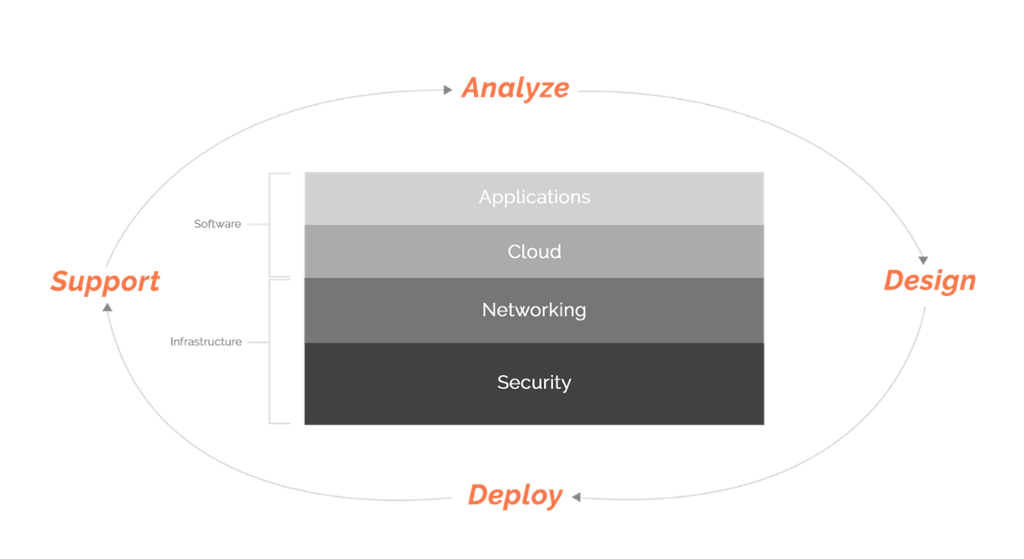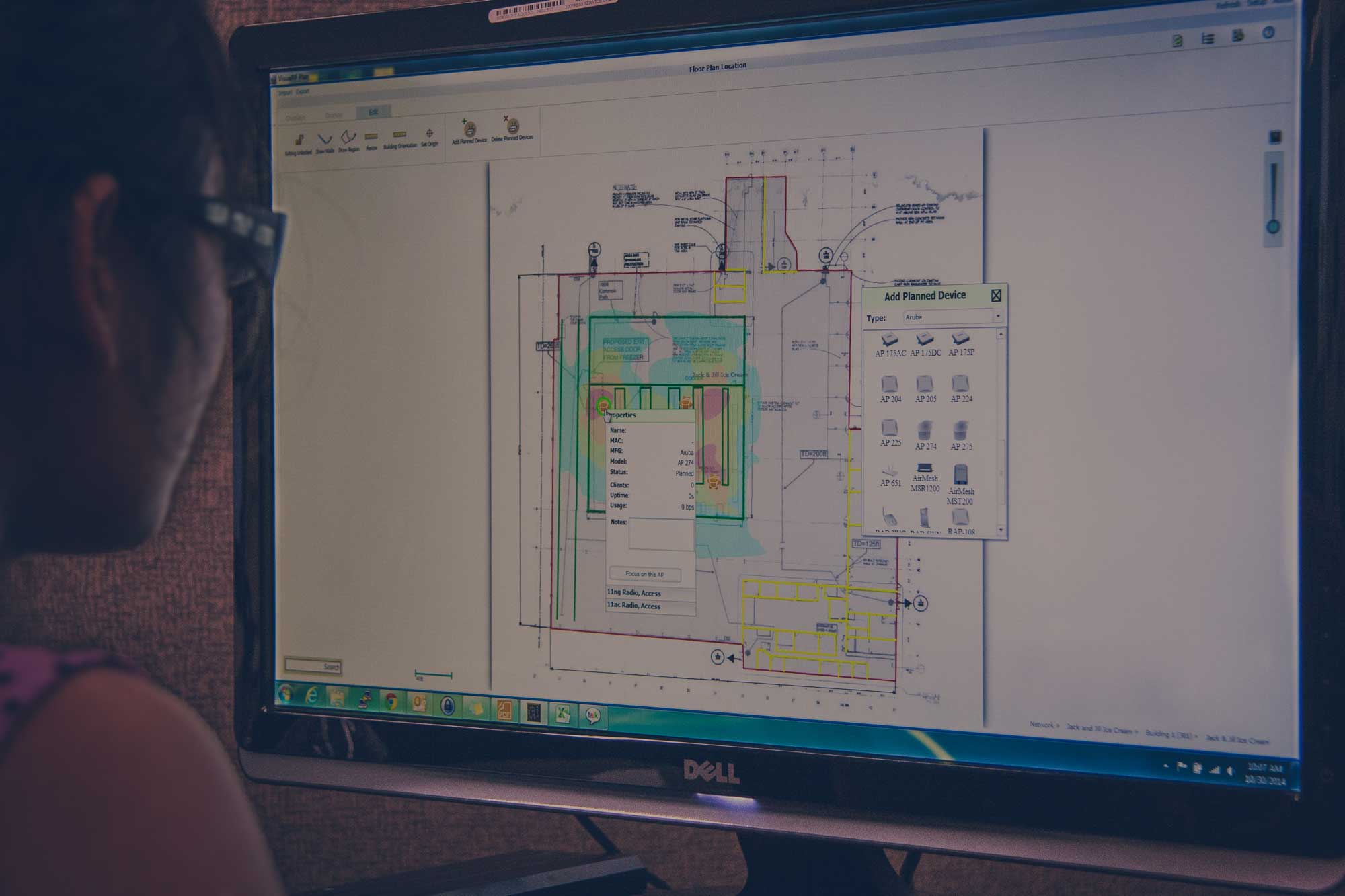
When was the last time you plugged a cord into a device to access the Internet? If you had to, could you even locate one of those bright blue ethernet cords?
Maybe you’ve got one jumbled in a drawer somewhere, wrapped around some rewritable blank DVDs and a digital camera—relics from a different technological time.
When we talk about WiFi planning for a “mobile-first” era, we mean that hardly anyone is physically connecting to the Internet using a wire anymore.
Internet users are on the move, and they are taking their devices from room to room, from building to building, and from work to home.
The connectivity shift from our desks to our hands is definitive; as of August 2017, StatCounter GlobalStats shows well more than half of global internet usage was mobile: 57.3%, vs. desktop at 42.7%.
And according to the Pew Research Center, the percentage of Americans who own smartphones is now 77%, up from 35% as recently as 2011. That’s a huge jump in just seven years.
The IoT boom is bringing with it more and more “smart” devices that depend on wireless connectivity to make our lives easier. Mobile devices like iPads and Chromebooks are being integrated into the school day from the elementary level on up.
Shoppers are using their phones to compare prices and read product reviews before making in-store purchases, and “connected factories” are using mobile devices and WiFi RFID tags to monitor the status of production lines in real time (and one such factory saw that “overall equipment effectiveness . . . increased by 24 percent, labor utilization by 10 percent, and throughput by 10 percent”).
Mobile-first has also been impacted by the rise of cloud-based business and social applications. Accounting systems, inventory management systems, learning management systems, email (Office 365), video streaming, social media—it’s all in the cloud. This means without access to the Internet and WiFi, we can't get anything done. It’s a sobering thought.
In short, every industry and every corner of our lives, whether at work, school, or play, calls for robust wireless networks that are designed to support the ever-increasing and ever-evolving mobile devices and cloud-based applications we use every day.
While there are many great solutions available today, a common problem most businesses run into is that they end up choosing their solution before they have a services process to continuously provide what they need.
Without a services process, we’ve found warehouses using solutions that were intended for retail stores and, worse yet, schools using consumer solutions built for use in our homes!
So, what's the easiest way for businesses to provide secure WiFi while also preparing their networks to support future growth in the mobile-first era?
By making sure they have the right services process in place before they choose their access points and other wireless infrastructure components.
With WiFi as a Service, the necessary services process is built into the solution. Let’s take a closer look at how the WiFi services process at SecurEdge works.
The SecurEdge WiFi Services Process
In the mobile-first era, technology is constantly changing, and again, no one is plugging into your network with a wire anymore.
Think of how far the iPhone has come in terms of speed, battery life, and capabilities since it was first released in 2007—and that’s just one product.
That’s why we need to have an ongoing, cyclical process around our wireless network solution to keep up with those changes.
When your WiFi is done right and has the right wifi services process in place, you'll guarantee your network is always prepared for future growth.
The SecurEdge services process looks like this:

- Analyze: We do our homework. We learn as much as possible about your physical environment and your requirements for coverage, capacity, and usage.
- Design: Our experienced, certified wireless engineers use the information you’ve provided as well as our own data from 1,000+ deployments across virtually every industry to create a customized WLAN design for your business.
- Deploy: Whether installing your networking components ourselves or by working with your existing installation team, we manage the installation of your network while minimizing disruption to your business.
- Support: Once we’ve deployed your network, our work is far from done. We treat your wireless network like a living thing. Our approach to support employs the three Ms: we Monitor your network, Manage upgrades and adjustments, and Measure the end-user experience from both the network’s and end user’s perspectives.
This services process functions on a continuous loop, giving your network the flexibility to keep up with changes over time. Those changes include:
- The RF environment
- Rising end-user expectations
- Increasing numbers of devices accessing your network
- New cloud-based systems and applications
Without a services process, when providing a secure wireless network at your business it’s not only harder to guarantee what type of results you’ll end up with, but also more difficult to maintain over time.
WiFi as a Service Makes Providing Secure WiFi Easy
Here’s the bad news: each step in the services process we just looked at can be 1) expensive and 2) beyond the scope of what your in-house IT staff is trained to do (or has time to do).
And now the good news: WiFi as a Service easily solves those challenges.
Our managed WiFi subscriptions combine everything a company needs to provide fast, reliable, secure Wi-Fi to its end users.
hardware + software + managed services = 1 monthly subscription
It’s a streamlined, more sustainable approach to wireless, and it’s arguably the best way to support your end users’ mobile-first demands today, and tomorrow.
Here are just a few of the benefits our subscriptions offer:
- No up-front capital expenses
- Fixed monthly payments
- Full warranty and support for the life of the system
- Flexibility to upgrade, change, and scale the solution (*so important in this mobile-first era, as we’ve been discussing)
- Role-based access control to allow all types of users and devices to securely connect on one system
- Next-generation security against malware and other malicious threats
- Integrated security for the IoT
Bottom Line
Effective WiFi planning is essential for businesses of all sizes to ensure reliable connectivity, seamless operations, and robust security. By conducting thorough site surveys, selecting the right equipment, designing a solid network infrastructure, implementing stringent security measures, and continuously monitoring and optimizing performance, businesses can create a WiFi environment that meets their specific needs and supports their growth objectives.
With careful planning and attention to detail, businesses can leverage WiFi technology to enhance productivity, streamline operations, and deliver an exceptional user experience for employees, customers, and guests alike.





